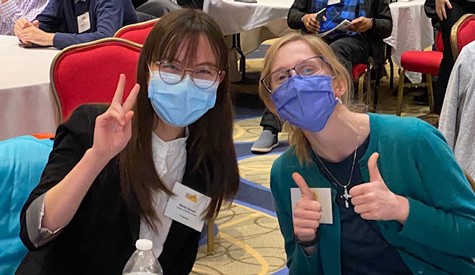COVA: W&M undergrad researchers mix with postdocs and grad students — and bring back two wins
The annual Commonwealth of Virginia Cancer Research (COVA) Conference is geared for cancer research trainees, specifically graduate students, postdoctoral researchers and clinical fellows.
But in November, a group of William & Mary undergraduates attended COVA, and two members of the class of 2023 came back to Williamsburg bearing “best presentation” honors.
Wendy Stewart, from Oliver Kerscher’s biology lab, won her “best” for her talk in Session 4C: Critical Events in Tumorigenesis. Willough Sloan, a student in Dana Lashley’s chemistry lab, was similarly recognized for her talk in Session 1E: Novel Approaches for Cancer Detection and Treatment I.
Kerscher, an associate professor in William & Mary’s Department of Biology, is the university’s liaison for the COVA conference. A couple years back, he perceived that some of William & Mary’s high-performing undergrad researchers would benefit from COVA.
“The neat thing about this conference is that it’s all about trainees,” Kerscher said. “It’s about postdocs, it’s about graduate students. And we have postdocs and graduate students at William & Mary — but we also have some really awesome undergraduate students.”
He said the COVA organizers were happy to have undergrad attendees — and they were welcome to submit abstracts if the students were interested in presenting. This year eight students and two W&M faculty mentors attended COVA and three students presented. Kushali Patel ’21, a student in Margaret Saha’s biology lab, joined Stewart and Sloan in making oral presentations.
Stewart gave her report on a collaboration between Kerscher’s lab and that of William & Mary biologist Matthew Wawersik. The focus on a protein called Chinmo, found in fly testes.
“Chinmo has a lot to do with fly testes developing properly,” Kerscher explained. “It turns out that testes can ‘forget’ that they’re actually male, and they can turn into a female state — or a mixed bag of female and male cells.”
He said the lab worked with the expression of Chinmo in yeast cells, and found a second related protein, Chigno — also a fly protein. The collaborators further found that if either Chinmo or Chigno were broken, the flies would get germ cell tumors.
“That means the flies get testicular tumors,” Kerscher said. “It’s a really scary thing, you know — but this could be a model for studying testicular cancers.”
The William & Mary Chinmo-Chigno collaboration just submitted a paper on their work (with Stewart as a co-author) to a peer-reviewed journal.
Sloan spoke about a set of projects that are interdisciplinary collaborations between the Lashley and Kerscher labs. The collaboration itself was generated by a William & Mary news story on Lashley’s work.
“Oli [Kerscher] read that story and then he reached out to me. He said, ‘Hey, wait a minute! You're making these cool compounds with potential anti-cancer applications? Would you be interested in doing in vivo testing on my yeast?” Lashley recalled.
And so began what she calls “an in-house pipeline: “We synthesize the molecules, and then Oli tests them on his yeast in vivo. So that's pretty cool.”
Lashley, a senior lecturer in the Department of Chemistry, said that Sloan joined her lab in spring of 2021. It was a particularly difficult time for an undergraduate to begin doing research, she said.
“Because these are students coming in from the pandemic, they all had completely virtual Organic I and Organic II labs for the most part,” Lashley explained. “These are people who've never touched a piece of equipment. They haven't handled live chemicals for the most part. So it was challenging, but Willough was very adamant about it.”
The Lashley lab has been working on ways to synthesize compounds that have promise as anti-cancer agents. Sloan’s COVA presentation detailed progress on the work from a collaboration that includes Kerscher and some other William & Mary researchers, plus a cohort of German scientists.
“Willough did research this summer. She synthesized a bunch of compounds, some of which were tested in Oli's lab in vivo, some of which were shipped to Germany to be tested in vitro,” Lashley said. “So there are two different types of tests happening. And so what we did is, I had Willough present on some results from last year, plus some new things that we have done since.”
When the time came for Sloan to speak at COVA, she was prepared. Lashley said that she had set up several practice sessions for Sloan, assembling an audience of research students to hear the presentation and ask questions.
“And she is just a natural at presentation. Who would have known? I didn't know that! And I think what should really be mentioned is that everyone else that was presenting in that session, they were postdoctoral students or doctoral students!” Lashley said. “Willough was the only undergrad — and she went last.”
Lashley added that the audience didn’t cut Sloan any slack, but asked a number of tough, detailed questions following the presentation.
“I was like — Holy cow! Don’t these people know she’s an undergrad?” Lashley said. “Why do they ask these aggressive questions? But Willough handled it with elegance and coolness. I was just blown away. And she got a really loud round of applause.”














